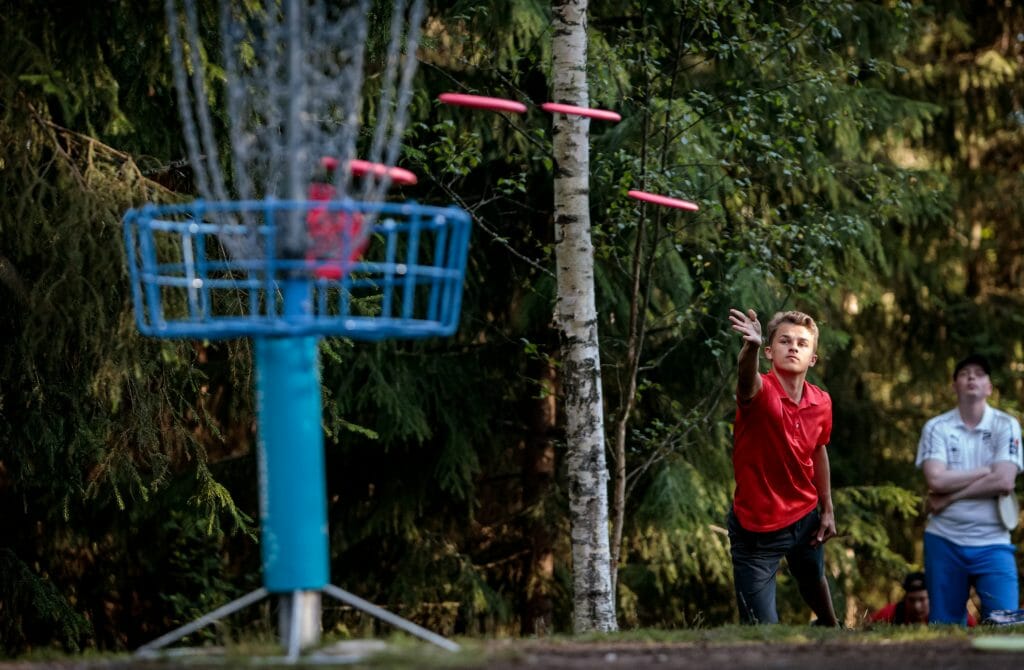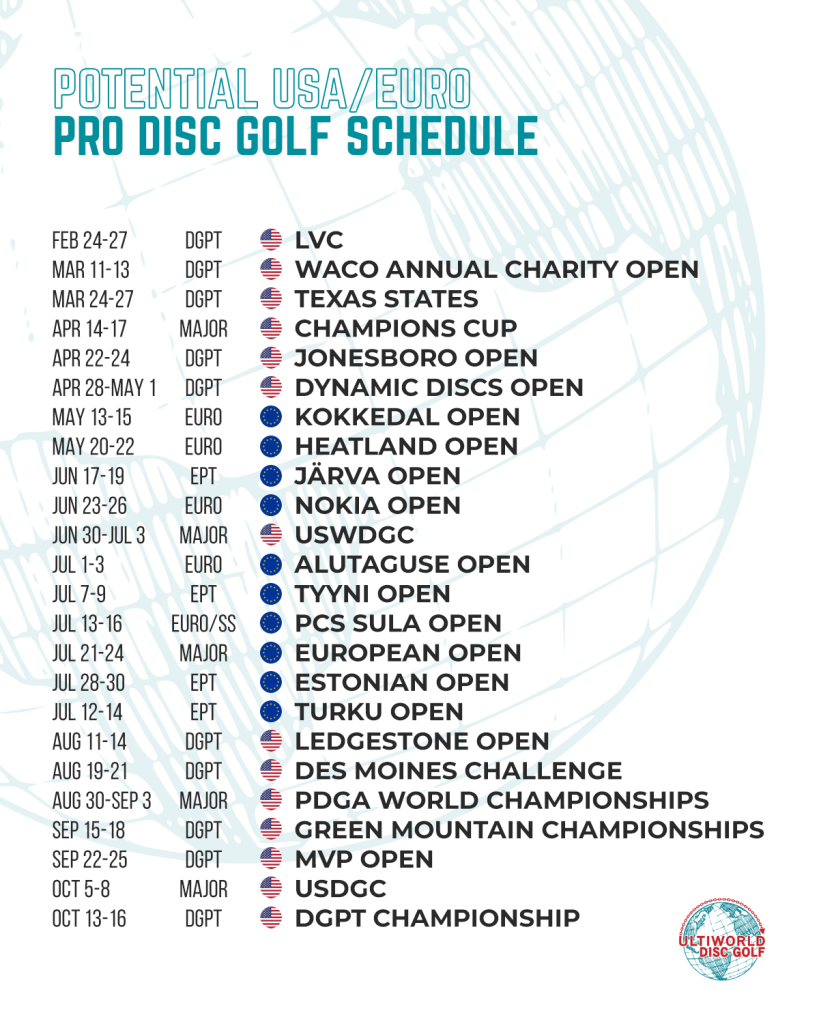February 3, 2022 by Jesse Weisz in News with 0 comments

This is the second post in our European Re-Open series that highlights European disc golfers as international travel reopens in 2022.
There is a lot to be excited about in the upcoming 2022 professional disc golf season. For many fans, the Europeans’ grand return to US competition is the most anticipated story of the year. Here are some of the questions and storylines we will be following around the Europeans’ impact on the tour.
1. Which European players at which tournaments?
From our research, we have found five women and fourteen men that plan on coming over for the early part of the US tour. This stretch from the Las Vegas Challenge in late February to the Dynamic Discs Open at the end of April includes five DGPT events, three Silver Series events, and, for those invited, one major, the new Champions Cup. Some Europeans may play all nine of those tournaments; others will only be at a handful. In May, we expect the large majority of Europeans to return home, followed by many Americans, to play the European swing of the tour, culminating in another major, the European Open.
When you plot out all of the Majors, Elite Series DGPT, European Pro Tour, and PDGA EuroTour events (full schedule here), it’s surprisingly possible to play the majority of both continents’ tours. If an MPO player plays in the US through DDO, then plays European events from May to July, and returns to the US for Ledgestone onwards, they can participate in 66% or more of the events in all three of the tours plus all of the Majors, not to mention plenty of Silver Series events. A European MPO player would need just two roundtrip flights across the Atlantic to make this tour a reality. A European FPO player would need to alter this schedule somewhat in order to also make it to the USWDGC.
Here’s a theoretical schedule:
 How many of our Atlantic neighbors will come back to the US after the European swing? Could a lack of success in the early season diminish the numbers for the latter part of the season? Or will some breakthrough performances and a potentially receding pandemic inspire more Europeans to come back to the US in August?
How many of our Atlantic neighbors will come back to the US after the European swing? Could a lack of success in the early season diminish the numbers for the latter part of the season? Or will some breakthrough performances and a potentially receding pandemic inspire more Europeans to come back to the US in August?
2. Who is the best female player in the world?
The most predictable impact of the Europeans touring the US is that FPO is going to be incredibly competitive. Three of the top four rated women in the world hail from Europe, yet that foursome of Paige Pierce, Kristin Tattar, Henna Blomroos, and Eveliina Salonen have squared off against each other in the same tournament only three times, most recently at the 2019 PDGA World Championships.
Of those three tournaments, Pierce won two: 2019 Worlds and the 2019 European Open. At the third — the 2018 Skellefteå Open — there was a four-way tie between Salonen, Pierce, Tattar, and Catrina Allen. Salonen won in a playoff.
Seeing a podium of Tattar, Blomroos, and Salonen at any tournament would not be shocking. Tattar gave us a taste of how talented she is on her all-too-brief US tour in 2021. In 2022, we should get a much better idea of who can lay claim to being the best female disc golfer on the planet.
3. Can the European men make lead cards — or win?
Europeans’ ability to win on the US MPO tour is a much bigger question mark. While Simon Lizotte has certainly found some success, the only other European MPO player to win an Elite Series title in the US is Markus Källström, who pulled it off back in 2007.1
Player ratings can give us an idea of what to expect. While 1040+ rated players took down nearly all of the Elite Series titles in 2021, we did see Nikko Locastro (currently 1032 rated) win WACO and Connor O’Reilly (currently 1014 rated) take down the Delaware Disc Golf Challenge. According to their ratings, Linus Carlsson (1035) and Niklas Anttila (1032) should at least be in the mix for podium finishes. There are eight European players with ratings higher than O’Reilly, so there is at least a puncher’s chance one of them will win an event.
4. Was there ratings inflation or deflation for the Europeans?
Since the pandemic began, there has been almost no competition between European and American disc golfers other than the mini 2021 tour of Tattar, Albert Tamm, and Silver Lätt. How this has affected player ratings has caused speculation about some “sort island” effect, given that the European players have been playing mostly in a bubble. Could their ratings be inflated? What about deflated, as we’ve seen in the past? We asked Chuck Kennedy, the co-creator of PDGA player ratings, what he thought about the possibility of the ratings being inaccurate due to the lack of connectivity. Here’s what he had to say:
The basic question is “What happens with player ratings within two player pools after two years that comprised a much larger pool where their initial ratings were generated?” Since the basic calculation is Ratings IN = Ratings OUT for propagators on average in every round, the stats maven might predict there would be no relative ratings differences between the two pools whether playing a separate set of events or playing events together over a 2-yr period at least within “normal” statistical variance.
However, on an individual basis, some players are getting better, some faster, some slower, or staying the same. There may even be aging, ill, or injured players whose ratings slipped over two years. In theory, the mix of these players should be similar in very large pools. However, only some of those players will be traveling to play in the other pool once they can connect again on a more regular basis.
The point being that tracking how well this small group of travelers play this year versus their ratings might be interesting but extrapolating their performances to verify some hypothetical inflation or deflation in the ratings process as a whole would be a statistical stretch.
We’ve already seen that players who travel across the pond tend to fare worse in their first event relative to their rating likely due to jet lag and general adjusting to a significantly different environment. As we’ve seen with Tattar, players can rebound if they can remain playing more events in that other continent.
What we can say if a player plays worse than their rating is they may have played relatively better than players in their isolated pool which inflated their rating relative to the other pool during that 2-yr period. Or if the opposite occurs, perhaps they slacked off during isolation to where their rating slipped but got back on the horse before traveling and surprised everyone by playing much better than expected on the other continent.
We’ll never have enough objective data to truly pin anything down but certainly enough limited data to provide fodder for social media speculation.
We will be tracking the Europeans throughout the season to see if, as a whole, they underperform or overperform their ratings coming into the season.
5. Will the Europeans push Americans off the Tour?
Elite Series events have the capacity for a limited number of players, and the Europeans are going to be taking some of that space in 2022. Take, for example, DDO: there are 120 slots in MPO and 48 in FPO. 14 European men (plus Lizotte) are scheduled to attend along with 3 European women. That’s 10% of the field, a significant chunk.2 They will surely push some Americans below the cash line. For reference, an MPO competitor needed to shoot an average round rating of 1007 over the first three rounds to cash at last year’s DDO.
While there are fewer women coming over from Europe, their impact will probably be greater. When Tattar, Bloomroos, and Salonen are at an event, nearly everyone in the field should expect to finish three spots lower in terms of payout. More so, this could greatly decrease opportunities for lead card visibility for much of the field, potentially affecting sponsorship value and player bonuses.
So will these newly added competitors knock some borderline American pros off the tour? It’s a real possibility.